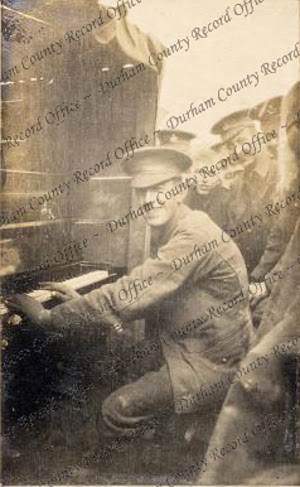This week we have another guest post by David Butler, former County Archivist.
C%2BWharton%2BPark.jpg) |
| Wharton Park on the 3rd Edition Ordnance Survey map, published 1919, Durham Sheet XXVII.1 |
In the
summer of 1919 British Government was demobilizing its armed forces and
disposing of surplus military equipment.
The City of Durham (with 263 other towns) was offered a tank in
recognition of the ‘splendid response of the citizens to the various appeals
made … for war loans’ and to commemorate the war.
The ‘battle-stained
war relic’, no.2783, arrived at Gilesgate Goods Station on 10 June, after a
fortnight’s journey from the ‘devastated battlefield of France’. However, there is evidence that, although
some of the presentation tanks came from France, many were training tanks from
Bovington Camp in Dorset. The tank was
‘one of the original ones’ (in fact it was a Mark IV tank, so not an original),
and
was under the command of Captain Farrar MC.
It was decided that the tank be located in Wharton Park and it was moved to North Road Station,
where it was unloaded on 17 June. Local
schools were given a half-holiday and large numbers of children congregated on
the slopes overlooking the station, while the great and the good of Durham
assembled in the station yard. Among others,
the mayor’s son, was allowed to travel inside the machine as it set off ‘at a
slow pace’ (the 27 ton tank had a best speed of 4 mph), preceded by the Earl’s
House Industrial School Band, the official party and a group of ex-servicemen -
the Comrades of the Great War.
The
journey so far had been accomplished safely, but as the tank was negotiating
the narrow entrance to the Park it demolished some railings. As it ascended the straight roadway it ‘made
a slight attack’ on the wall to the left. The tank
was then required to make another acute turn, this time to the left. In doing this it broke ‘the chains’
(presumably railings) and demolished some timber, before continuing to its
final location ‘near to the rifle range’.
From its final south-facing orientation it is probable that this last
stage of the journey was made in reverse.
While being manoeuvred onto its final wooden base, two more incidents
occurred. Captain Farrar was not
satisfied with its initial positioning and ordered the driver to reverse. In the process the tank came very close to
the edge of the steep drop down to North Road ‘to the alarm of the onlookers’
and it also collided with a telegraph pole.
 |
| D/DLI 7/920/12(10) Sketch by Robert Mauchlen of a 'male' tank, Arras sector, France 1917 |
Speeches
were made and Captain Farrar spoke first and presented the tank to Durham, on
behalf of the National War Savings Association.
He explained that ‘for the last four years he had been engaged in
actions, not words’, and therefore they should not expect ‘a speech up to the
standard of a member of the House of Commons’.
He explained that no.2783 was a female tank, which carried machine guns
and were designed to attack enemy soldiers, while male tanks carried six-pounder
guns and were intended to tackle pill boxes and other obstructions. He implied that no.2783 had first been at
Vimy Ridge and Arras in April 1917 (although production of Mark IVs did not
begin until May of that year).
Research
shows that Walter Farrar had been in the Heavy Machine Gun Corps (later the
Tank Corps) and went to the Western Front in May 1917. He was awarded the Military Cross in 1918 for
destroying an enemy machine gun position and capturing the gun, and for using
his tank to span a gap in a damaged bridge to keep the crossing open.
The
Mayor commented on the magnificent response of Durham to the war loans, and
hoped that the tank would be a memorial to all those who had contributed to the
victory. The Dean said that he did not
know why he had been asked to take part in the celebration, unless it was to
christen the tank. Hitherto no.2783 was
‘a nameless child’ and he christened it the Mayoress. Other members of the official party then made
their contributions and the afternoon’s proceedings closed with the singing of
the National Anthem.
Not many photos are known to exist of the tank in Wharton
Park. The Newcastle-based daily the Illustrated Chronicle carried four
photographs of the day (one of which was printed upside down). Another two photographs feature in books by
Michael Richardson.
Although
Mayoress was to remain in the park
for the next 17 years, as early as March 1925 its future was under
consideration, and it was only on the casting vote of the mayor that it was decided
that the tank should remain. Six years
later, in September 1931, the Parks Committee decided to overhaul and re-paint
the tank. However, on 7 October 1936 the
City Council resolved that it should be sold and the proceeds allocated to the
Children’s Playing Field. There does not
appear to have been any opposition to this, but it has not proved possible to
discover how much was raised by the sale.
The heritage Lottery Fund and The Big Lottery last year awarded a grant of £2.45 million to restore Wharton Park. Work is due to commence February 2015 and more information can be found here: http://www.durham.gov.uk/whartonpark
![P.H.B. Lyon with fellow officer prisoner at Karlsruhe Camp, Germany, [12 June 1918] (D/DLI 7/424/3(8))](https://blogger.googleusercontent.com/img/b/R29vZ2xl/AVvXsEijWA_lJO3vHp0clasUSamvhIwcc7Kajh1cCPlTp0PDxDNSLJyP1Ucx2kRwG6lYA70eRzIg2L8IZ6Zn0ns71LmmgFVM5lu7DuwZRTAIeQF_eMshFQBp4l-81mALQEhrZbSDUnxljigRSXA/s1600/d_dli+7_424_3_8+Lyon+Karlsruhe+250.jpg)




C%2BWharton%2BPark.jpg)



